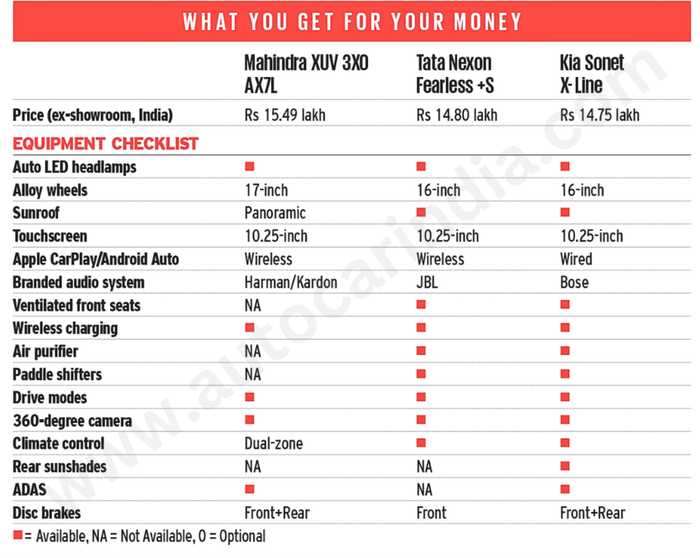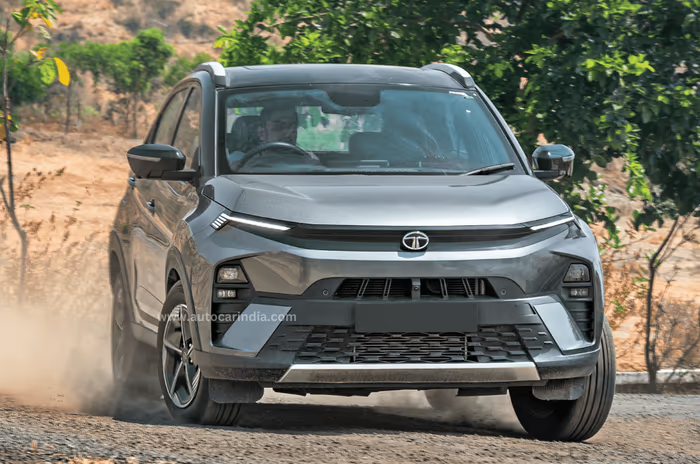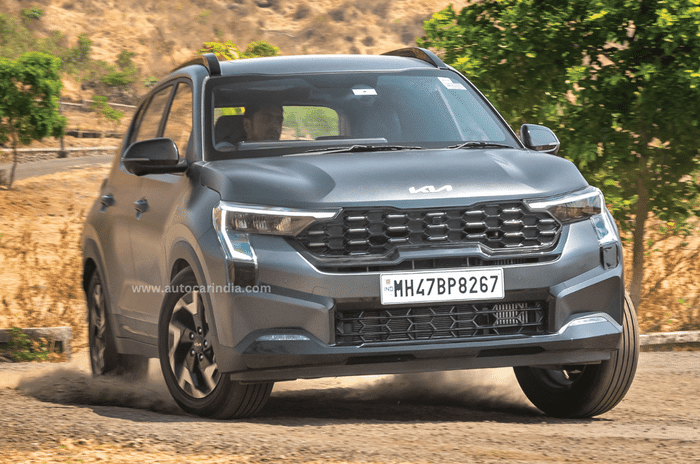Mahindra XUV 3XO vs Tata Nexon vs Kia Sonet: compact SUV showdown
The XUV 3XO is more upmarket and desirable than the XUV300 it replaces. We find out if it is the best compact SUV in the market.
Published on Jun 21, 2024 02:50:00 PM
89,746 Views
Follow us on

XUV 3XO feels luxurious, but you’re seated knees-up.

The Nexon's chair-like seating offers good overall support.

The Sonet is the least spacious, but with most feel-good features.
Mahindra has upped its game with the XUV 3XO. It is feature-rich, packs in strong engines, and with prices ranging between Rs 7.49 lakh and 15.49 lakh, the Indian carmaker has carpet-bombed the compact SUV segment. Even though no less than 11 contenders are fighting for market share in this space, two capable of putting up a tough fight are the Kia Sonet – renowned for its refined and polished demeanour – and the bestselling Tata Nexon.
For this comparison, we’ve brought together their fully loaded turbo-petrol automatic variants. At Rs 15.49 lakh, ex-showroom, the XUV 3XO AX7L is the priciest of the lot, while the Nexon Fearless +S DCT and Sonet X-Line DCT are more affordable at Rs 14.80 lakh and 14.75 lakh, respectively.
Being compact SUVs, they’re all similarly sized, but the XUV 3XO is the widest, tallest, and has the longest wheelbase of this trio, if only by a few millimetres. The Sonet is the narrowest. The Nexon is the lowest but it boasts the highest ground clearance of 208mm.
| Mahindra XUV 3XO Price, Mileage, Specifications, Features and Variants | |
|---|---|
| Brand | Mahindra |
| Model Name | XUV 3XO |
| Mahindra XUV 3XO Price | ₹ 8.50 - 17.84 lakh |
| Mahindra XUV 3XO Range/Mileage | Petrol : 17.96 - 20.1kpl | Diesel : 20.6 - 21.2kpl |
| Mahindra XUV 3XO Specifications | SUV | 5 doors | 5 seats View All Specs |
| Mahindra XUV 3XO Features | LED headlight | 26.03-inch Touchscreen display | 6 airbags View All Features |
| Mahindra XUV 3XO Variants | 1.2 Petrol MX1 | 1.2 Petrol MX2 Pro | 1.2 Petrol MX3 View All Variants |

All three have already gone through their respective mid-life updates, and the XUV is the freshest here. It gets an EV-like closed-off grille finished in piano black, distinctive LED lights, a stylish set of 17-inch alloys, and a neat set of tail-lamps connected by an LED bar. The Sonet’s facelift came earlier this year, and it now looks like a barely shrunken Seltos, which is no bad thing. It features an array of cuts and muscular lines, all of which have come together beautifully. The Nexon is also a looker, and in its latest avatar, its more mature appearance is likely to have universal appeal.
3XO vs Nexon vs Sonet: interior
Besides having the largest cabin, the XUV 3XO’s bright and airy ambience and two-tone colour scheme feel inviting; its segment-first panoramic sunroof further elevates the sense of space. The inclusion of soft materials on the dashboard and door pads does well to lift its premium feel. The buttoned dual-zone climate control panel and its new free-standing touchscreen with physical shortcut keys and a volume knob are convenient. The screen is easy to use, but the music system sadly doesn’t meet the high expectations set by Harman/Kardon.

The new digital instrument cluster integrates a blind-spot monitor that activates when you indicate. However, its execution isn’t as nice as the Sonet’s because the camera feed is delayed. Several functions – like those for ADAS – are buried deep within the instrument panel menus, and this isn’t intuitive.
The front seats are plush, but those with larger frames will find the side bolstering a bit intrusive. The rear seat is low, which results in a knees-up seating position, but seating three abreast will be the comfiest as it is the widest and roomiest. Adding to the comfort are the soft cushioning and a universally appealing backrest angle.
On paper, the 3XO’s boot is the smallest, although Mahindra has reprofiled the bumper and tailgate, and the spare tyre is now a space saver, which helps liberate some space. As a result, the actual cargo-carrying capacity is similar to the other two, but its high boot lip makes it inconvenient to load/unload heavy luggage.

The Tata Nexon’s dash looks modern, with its free-standing touchscreen taking centre stage. Lending an upmarket look is the touch-operable climate control panel and the two-spoke steering featuring an illuminated logo. There’s generous use of piano black trim to spruce up its cabin, but these surfaces are highly reflective and pick up fingerprints and smudge marks. And Tata could have done a better job with the digital instrument cluster readouts, which are tiny and not easily legible. In terms of fit and finish, quality and ergonomics, there’s still a lot of scope for improvement.
The Nexon’s front seats are the least comfortable on account of their firm cushioning and limited thigh support, especially for taller folk. What’s nice is their ventilation function, which the Mahindra misses. Rear passengers are seated higher than in the XUV, in a chair-like position, and the rear bench is very comfortable and supportive for two adults; a third adult will feel unwelcome as it isn’t as wide as the XUV 3XO.

The Kia Sonet has the smallest cabin, and what exacerbates the issue of space further is this ‘X-Line’ variant, which has a black interior; red stitching and silver highlights break the monotony to some extent. Unlike the Mahindra, there aren’t any soft-touch materials, but in terms of fit and finish, switchgear’s tactility, and the execution of its user interface, the Sonet sets the benchmark and remains the one to beat. Its ventilated front seats are the broadest and most accommodating, and the driver’s seat gets an electric recline and slide function. Its rear seat is reasonably spacious for tall adults, with scooped-out front seatbacks and roof, which free up more knee and headroom, respectively. However, as it is narrow, this space is best for two adults.

3XO vs Nexon vs Sonet: performance
What makes the XUV 3XO the most powerful compact SUV in the country is Mahindra’s 1.2-litre direct injection turbo-petrol that produces 131hp and 230Nm. Like its rivals, this is a three-cylinder unit, but it is among the smoothest and most refined. Power comes in strong beyond 2,300rpm, and while it doesn’t rev as high or as quickly as the Sonet, performance is rather enjoyable on account of its strong midrange. But at low speeds, the turbo lag followed by a sudden gush of power can feel overwhelming and will coax you to ease off the accelerator pedal.

Complementing this engine is a 6-speed torque converter, which is quite smooth, if conservative, in the way it downshifts. As a result, you occasionally miss having paddle shifters; you’ll have to make do with a tiptronic mode at the lever and its clunky shift action when you want manual control over the gearbox. Both the Sonet and Nexon use 120hp turbo-petrol engines and 7-speed dual-clutch automatic transmissions with paddle shifters, but the similarities end there. Tata’s turbo-petrol delivers its performance in a progressive manner with negligible lag, and its dual-clutch transmission brings with it a newfound seamlessness, which its prior AMT gearbox couldn’t deliver. Since its focus is smoothness, this gearbox hesitates before downshifting to avoid any sudden spikes in performance, and even if you use the paddles, it will not oblige with aggressive downshifts. So, sporty it isn’t. Refinement also isn’t the Nexon’s strong suit. You can feel vibrations inside the cabin at idle, and at low speeds, the Nexon’s gearbox can feel jerky, particularly while decelerating.

The Sonet’s 1.0-litre engine is the smallest and isn’t devoid of lag below 2,000rpm. But it packs quite a punch when in boost, and being a free-revving unit, it feels quite entertaining. In this company, its dual-clutch auto is the quickest and feels reactive to user inputs, thus limiting the need for manual intervention. And when you tug the paddle shifters, unlike Tata Nexon’s, these are quite obedient and support aggressive downshifts, thus adding to its sporty experience.
We strapped our testing gear to these cars, and the results were rather predictable. The Mahindra 3XO accelerated from 0–100kph the quickest, and its rolling acceleration times were also better than the others. The Sonet out-accelerated the Nexon in 0–100kph and 40–100kph sprints. However, the Tata was quicker than the Kia in a 20–80kph sprint.

3XO vs Nexon vs Sonet: ride and handling
Mahindra has nailed the XUV 3XO’s ride and handling. The compact SUV rides comfortably at all speeds and absorbs all undulations and imperfections brilliantly. Its high-speed manners are confidence-inspiring, and it does an incredible job of masking its speed, too. Most users will love the steering’s effortlessness at city and parking speeds, and even though its weight can be altered by changing the drive modes, the added heft in some other modes feels artificial and hardly translates into any feel or feedback.
The Nexon’s chassis exudes an inherent toughness that becomes apparent while tackling bad and broken roads. It feels firm and a bit jittery at low speeds, but on the flip side, it feels glued to the road at high speeds. Its steering feels overly sharp and pointy, especially for its intended use.

The Kia Sonet’s ride feels relatively choppy at all speeds; rear occupants especially will feel a lot of vertical movement. So it isn’t as settled as its rivals. The steering is fluid and consistent, but the XUV has an edge when it comes to sheer lightness.
3XO vs Nexon vs Sonet: verdict
It isn’t hard to see why the Nexon is among the country’s bestsellers. Buyers will appreciate its tough build, spacious and well-equipped interiors, and solid 5-star crash rating. However, rivals do a better job in terms of refinement and reliability.
The Kia Sonet is the most affordable, and it performs its duties with great finesse, which is why it comes across as a polished, well-rounded car. But it gets the second spot because it is the least spacious and not as confident as the others at highway speeds.

Taking top honours in this comparison is the Mahindra XUV 3XO, despite the significant premium it commands over its direct rivals. That’s because it has the most spacious and luxurious cabin, its turbo-petrol feels the strongest of the bunch, and it drives and feels like it belongs to a segment above. That’s why it is our pick in this segment.

Also see:
Mahindra XUV 3XO vs Tata Nexon vs Kia Sonet comparison video
Mahindra XUV300 gets discounts of up to Rs 1.79 lakh in June
Tata Altroz Racer launched at Rs 9.49 lakh
Copyright (c) Autocar India. All rights reserved.






.jpeg?w=234&h=156&q=90&c=1)


Comments
Member Login
Personal Details
No comments yet. Be the first to comment.